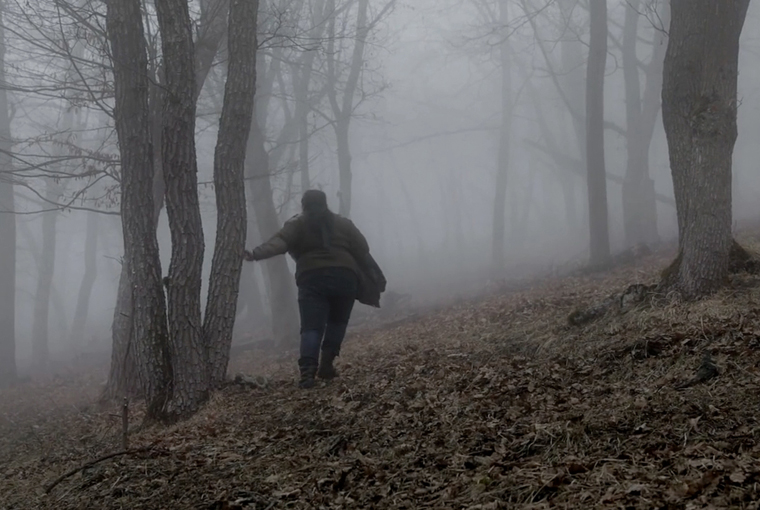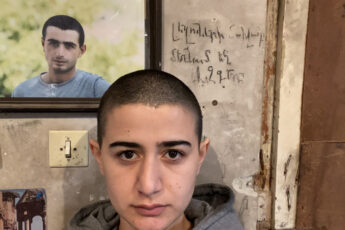Women on the Verge of Exploding
Silva Khnkanosian’s Nothing to Be Afraid Of (2019)
Vol. 100 (December 2019) by Zoe Aiano
In a remarkable opening shot lasting four minutes, we see a distant figure on a grassy hillside standing so still it seems as though the image has frozen. Eventually, the figure comes to life, speaking into a walkie-talkie, although still no sound can be heard beyond the very low hum of nature. They light a fuse and retreat out of the frame before the silence is erupted by a blast substantial enough to make the camera shake, as chunks of earth come hurtling towards the lens.
This is the introduction to the Nagorno-Karabakh region as presented in Silva Khnakanosian’s documentary Nothing to Be Afraid Of. Specifically, the film depicts the truly Sisyphean work of the teams painstakingly detecting and disarming the thousands of landmines still strewn across the mountains since the conflict in the 1990s. The focus of the film is placed squarely on the minutiae of their labor, which it outlines in all its hypnotically ritualistic detail. Inch by inch, five women scan the land with their metal detectors, carefully and onerously marking out the territory covered with a system of stakes attached to string. Once a source of metal is detected, its perimeters are precisely outlined and a small section of earth delicately scraped away until its exact nature is ascertained. If it is a landmine, a whistle is blown to warn the rest of the team and it is summarily blown up.
The tension is palpable, which should be a given considering the subject matter, but which is nevertheless helped by the filmic style. The whole approach is very minimalistic, with the vast part of the footage simply showing the women at work, often from fairly close up. While the editing does not exactly follow the standard conventions of continuity, preferring to reveal lapses in time instead of hiding them, it seems to stay true to the process. The slow pacing in particular plays a crucial role in both underscoring how meticulous the women have to be while also building up the suspense. In one scene, a worker visibly sweats after discovering a wire sticking out of the ground, yet she manages to calmly and methodically continue her excavations, only to eventually pull the wire out – which is attached to nothing. In another scene, a young woman grapples with massive and unwieldy tree roots and huge rocks, a struggle that is made even more demanding by the need to minimize vibrations and sudden movements. Perhaps the most powerful shot of the documentary is a simple landscape view of the mountains, which is perfectly timed after an extensive and grueling sequence of a tiny section of land being examined. As the camera lingers on the vast rocky expanse, it really hits home just how unconscionably massive the job is, and how mindlessly cruel the act of placing the landmines was in the first place.
Khnakanosian makes the right decision in choosing not to use music to create dramatic effect and instead trusting in the inherent power of the subject and images. As a whole, silence plays a key role in the construction of the film, which uses little or no dialogue, at least while the work is taking place – the women are occasionally shown in their communal life in a makeshift home. This absence of speech comes off as artificial at times, not least because it is hard to imagine that these women truly spend their days on the constant verge of sudden death without at least uttering the occasional expletive. Indeed, not only does the film seemingly cut out speech, it goes so far as to mute conversations that can be seen taking place on screen. It is not entirely clearly whether the purpose of this is artistic or ethical, which makes it somewhat distracting. Nevertheless, overall the hushed quality of the film is effective in creating a sinister atmosphere of anticipation and in making the impact of the explosions even more effective.
Parallel to this lack of verbalization, the documentary also refrains from offering much in the way of contextualization. Indeed, the location of the events is only revealed as Nagorno-Karabakh some 20 minutes into the film, after a long sequence of the demining process. Even after this fact is established, little more information is given until the final text detailing the truly staggering figures concerning the number of landmines planted and the injuries and deaths that have resulted from clearing them. No background is provided to the conflict itself, however. With this, the film is clearly making a statement about the universality of war and its horrific legacies without providing a politicized commentary. Rather, it stays true to its central goal of revealing the immensity and absurdity of the task taken on by these people. The film also reveals very little about its protagonists, which makes sense in light of this apolitical stance and also the overall minimalist approach. Nevertheless, it is impossible to not ask questions about the gender issues at play. Why is this perilous job carried out exclusively by women, except for the two men who are left in charge of the detonations? Even more basically still, what incentive could possibly be strong enough to make anyone do this job? Is it caused by economic need or some kind of humanitarian or patriotic impulse? Of course, it isn’t possible to answer everything in one film and Khnakanosian was right to pick and choose in the interest of creating a coherent work, still the questions remain.




Leave a Comment